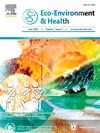生物膜电极反应器中混合电子供体供应的氮去除性能和电子竞争机理研究
IF 17.6
引用次数: 0
摘要
在本研究中,在生物膜电极反应器(BER)中开发了一种独特的“倒T”型电极结构,通过氢自养反硝化和异养反硝化的协同作用,实现了卓越的脱氮效果。与生物膜反应器(BR)的单一异养反硝化相比,BER系统的弱电刺激促进了原位产氢、电子传递和利用,使进水COD/N比和进水COD/N比的NO3-去除率均提高了20%。相反,在COD/N浓度为6.0 ~ 8.0 mg/L的情况下,NO2-积累显著。热单胞菌(Thermomonas)、Pelomonas和Hydrogenophaga等非异养反硝化菌在BER中富集,相对丰度超过1.0%,有利于氢自养反硝化途径。基于不同电子受体组合共存时的多电子供体利用结果,尽管H2在BER中作为额外的电子供体,但仍然可以检测到电子竞争。值得注意的是,亚硝酸盐还原酶(Nir)是最弱的竞争者,导致NO2-还原能力受到限制。基于对电子竞争特征的分析,BER系统中潜在的NO3-代谢途径主要由异养反硝化过程驱动。在BER系统中引入的电有利于通过原位产氢、从电极直接供应电子、改善功能性微生物活性和增强酶活性来促进氮的去除。本文章由计算机程序翻译,如有差异,请以英文原文为准。

Mechanistic insights into nitrogen removal performance and electron competition with mixed electron donor supply in a biofilm electrode reactor
In this study, a unique electrode configuration in the form of an “inverted T” was developed in the biofilm electrode reactor (BER), enabling superior nitrogen removal via the synergistic effect of hydrogen autotrophic denitrification and heterotrophic denitrification. In contrast to the sole heterotrophic denitrification in the biofilm reactor (BR), weak electric stimulation in the BER system promoted in situ hydrogen production as well as electron transport and utilization, resulting in a notable 20% improvement in removal efficiency for both influent COD/N ratios. Conversely, notable accumulation occurred under both COD/N ratios, with concentrations ranging from 6.0 to 8.0 mg/L. The enrichment of non-heterotrophic denitrifiers, such as Thermomonas, Pelomonas, and Hydrogenophaga, was observed in the BER with a relative abundance exceeding 1.0%, contributing to the hydrogen autotrophic denitrification pathway. Based on the outcomes of the multiple electron donor utilization in the coexistence of different electron acceptor combinations, despite H2 serving as an additional electron donor in the BER, electron competition was still detectable. Notably, nitrite reductase (Nir) emerged as the weakest competitor, resulting in a constrained reduction capacity. Based on the analysis of the electron competition characteristic, the potential metabolic pathway in the BER system was primarily driven by heterotrophic denitrification processes. The introduced electricity in the BER system was favorable for facilitating nitrogen removal through in situ production of hydrogen, direct supply of electrons from the electrode, improvement of functional microbial activity, and enhancement of enzymatic activity.
求助全文
通过发布文献求助,成功后即可免费获取论文全文。
去求助
来源期刊

Eco-Environment & Health
环境科学与生态学-生态、环境与健康
CiteScore
11.00
自引率
0.00%
发文量
18
审稿时长
22 days
期刊介绍:
Eco-Environment & Health (EEH) is an international and multidisciplinary peer-reviewed journal designed for publications on the frontiers of the ecology, environment and health as well as their related disciplines. EEH focuses on the concept of “One Health” to promote green and sustainable development, dealing with the interactions among ecology, environment and health, and the underlying mechanisms and interventions. Our mission is to be one of the most important flagship journals in the field of environmental health.
Scopes
EEH covers a variety of research areas, including but not limited to ecology and biodiversity conservation, environmental behaviors and bioprocesses of emerging contaminants, human exposure and health effects, and evaluation, management and regulation of environmental risks. The key topics of EEH include:
1) Ecology and Biodiversity Conservation
Biodiversity
Ecological restoration
Ecological safety
Protected area
2) Environmental and Biological Fate of Emerging Contaminants
Environmental behaviors
Environmental processes
Environmental microbiology
3) Human Exposure and Health Effects
Environmental toxicology
Environmental epidemiology
Environmental health risk
Food safety
4) Evaluation, Management and Regulation of Environmental Risks
Chemical safety
Environmental policy
Health policy
Health economics
Environmental remediation
 求助内容:
求助内容: 应助结果提醒方式:
应助结果提醒方式:


